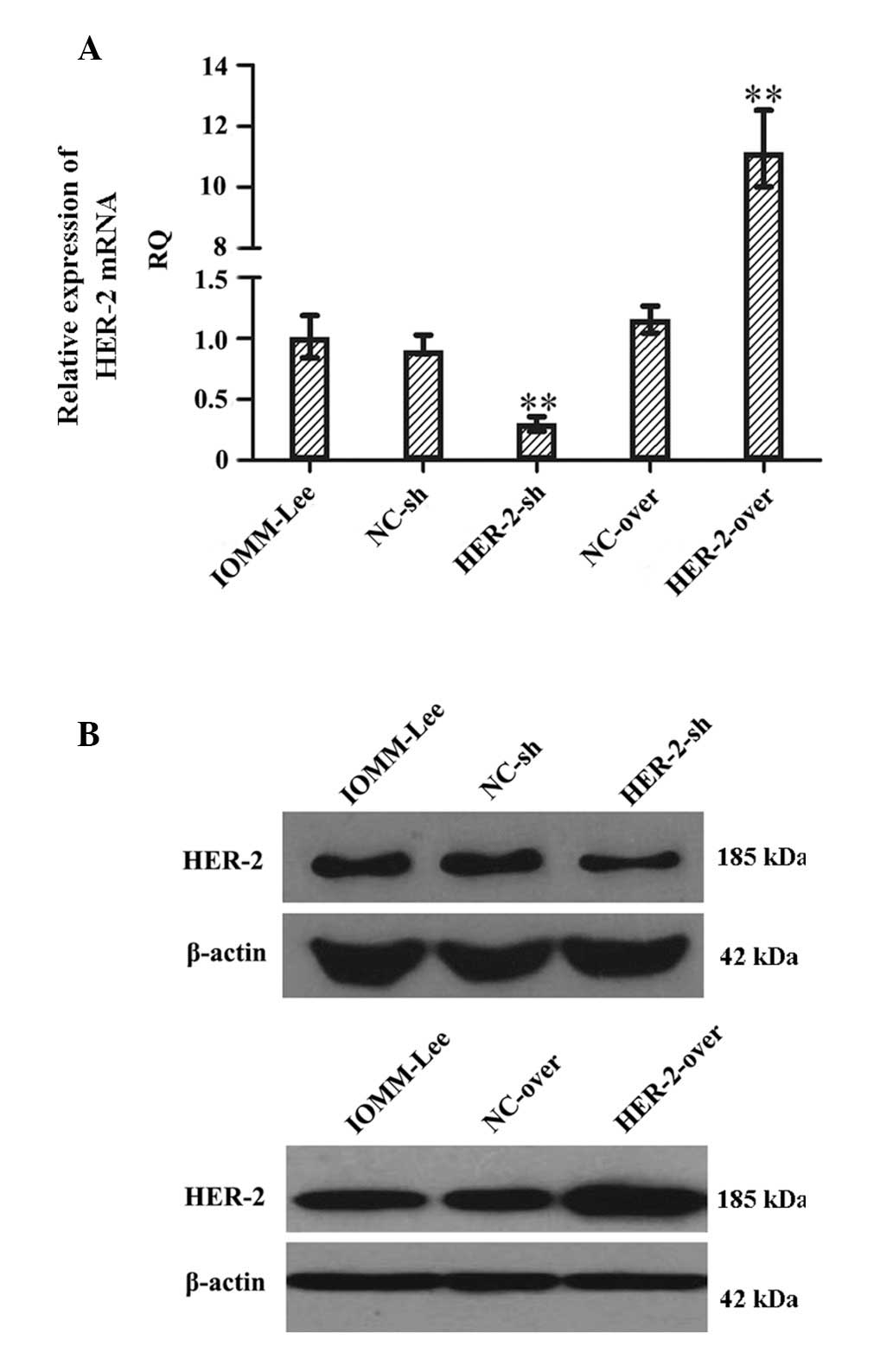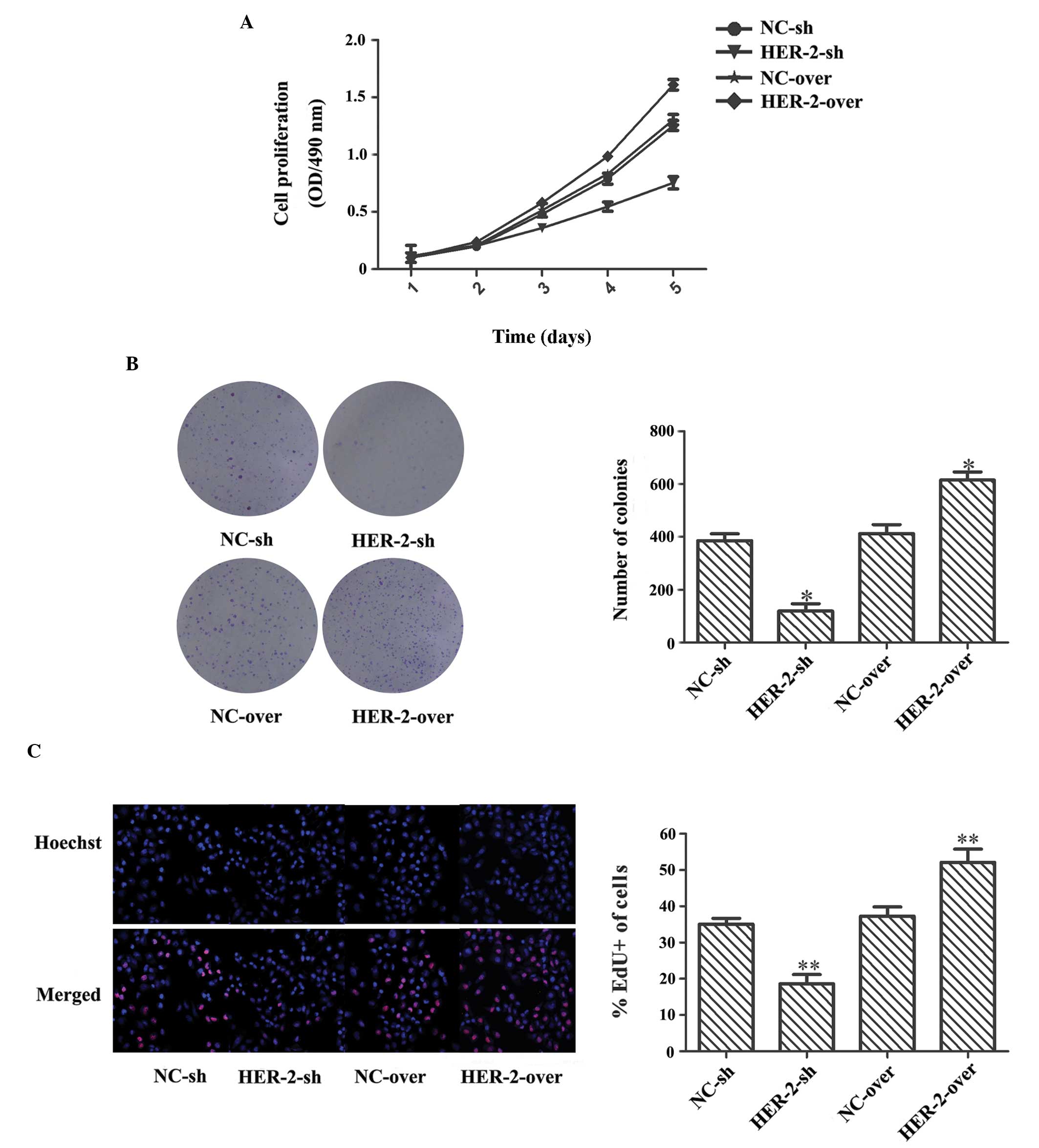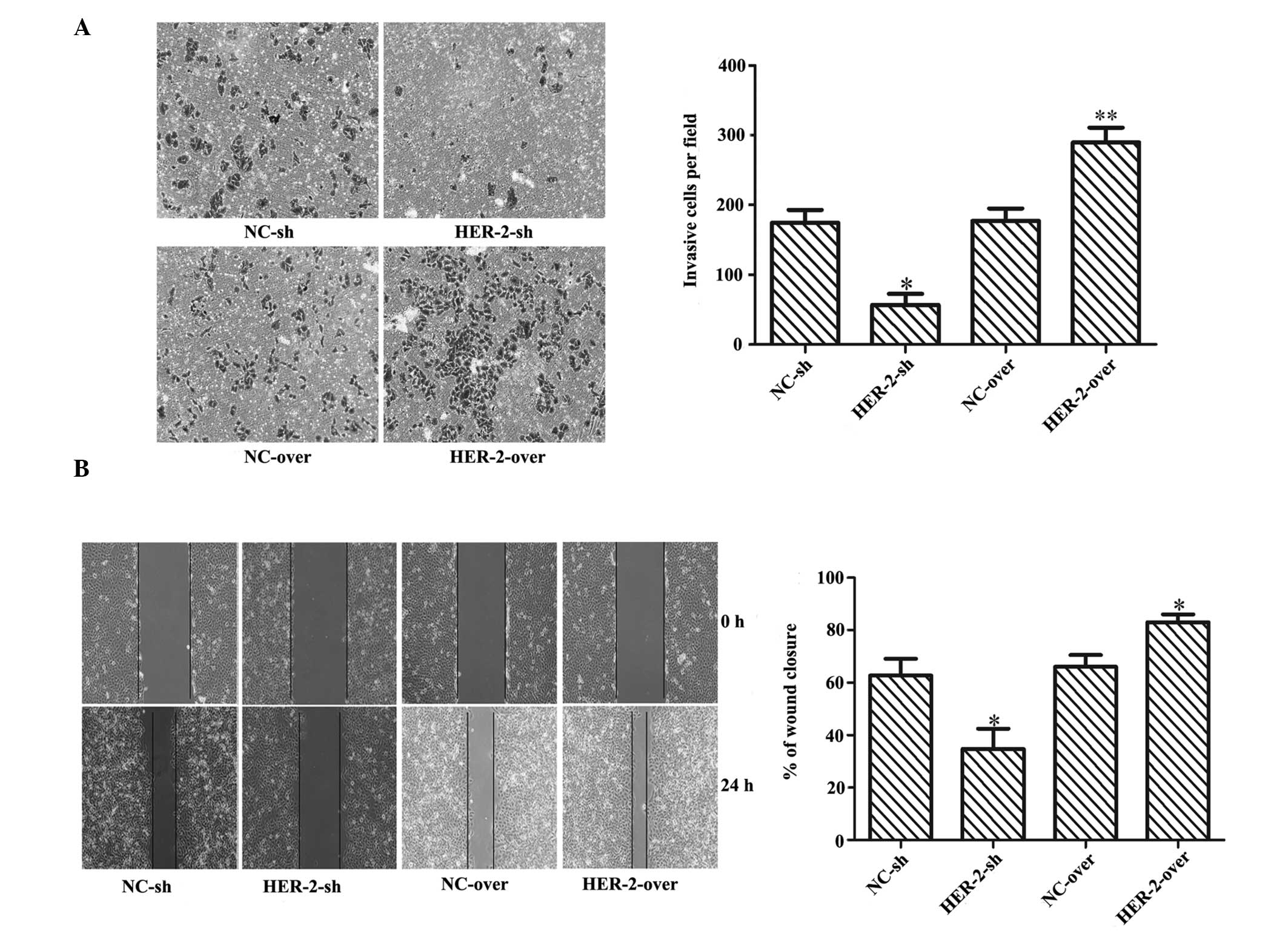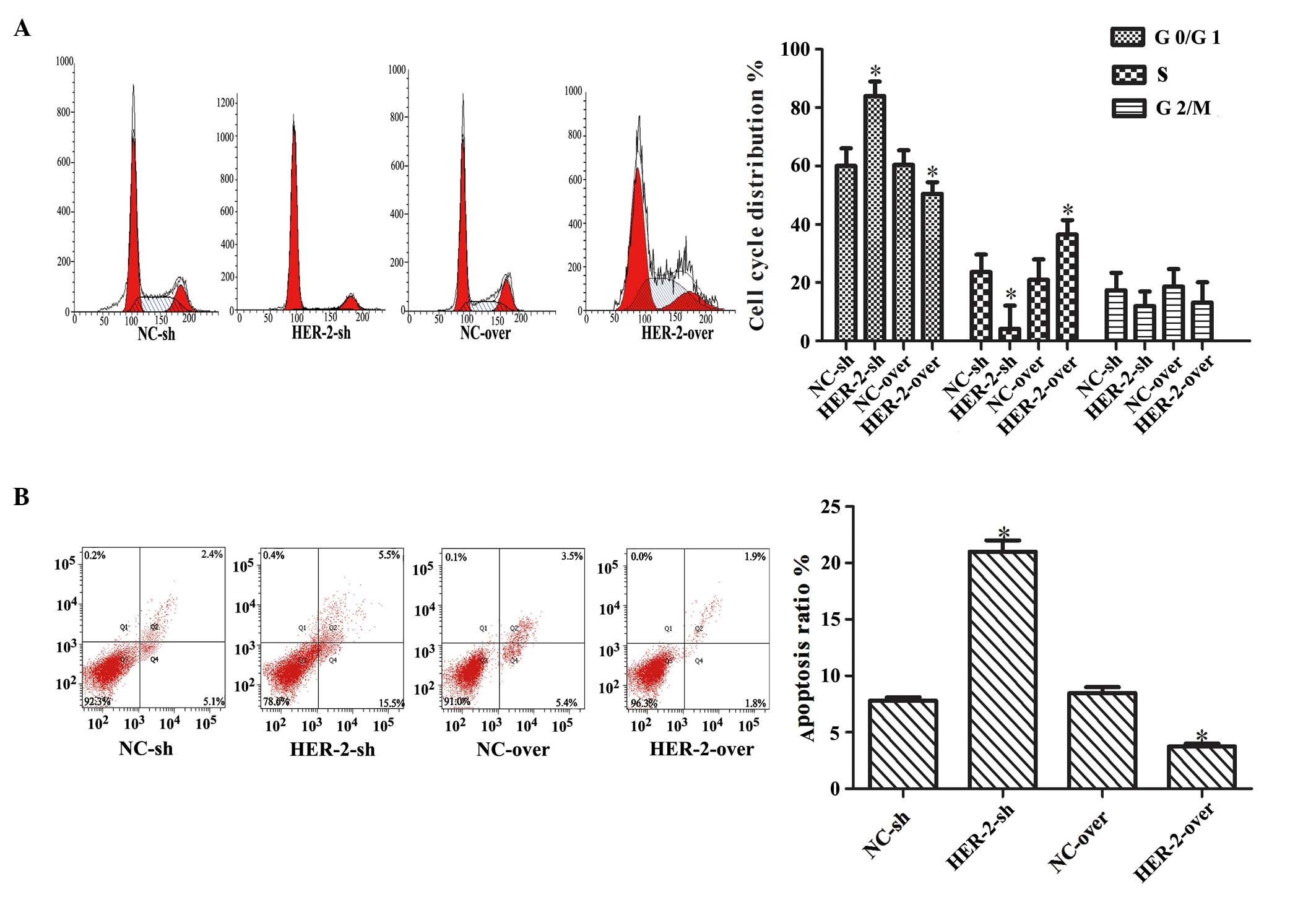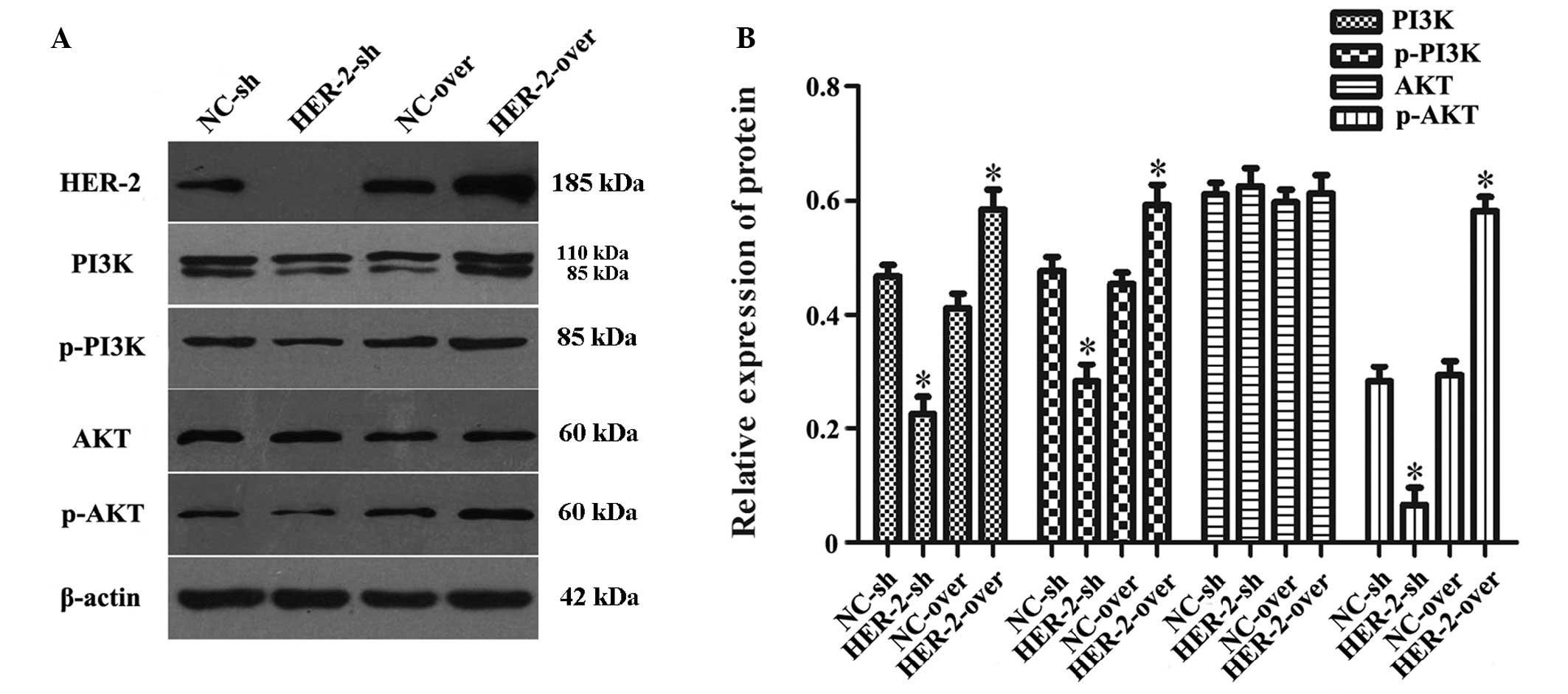Role of HER-2 activity in the regulation of malignant meningioma cell proliferation and motility
- Authors:
- Published online on: May 21, 2015 https://doi.org/10.3892/mmr.2015.3805
- Pages: 3575-3582
Abstract
Introduction
Meningiomas are the second most common type of tumor of the primary central nervous system and accounts for 24–30% of all reported brain tumors, with malignant meningiomas (WHO grade III) accounting for 1–3% of meningiomas (1–3). Invasive and malignant meningiomas present a significant therapeutic challenge due to high rates of recurrence and invasion into the surrounding bone, brain, neural and soft tissues (4,5). Therefore, understanding the molecular mechanism of invasion may assist in designing novel therapeutic approaches to reduce the requirement for repeat surgery, decrease morbidity rates and improve patient survival rates.
The HER-2 gene is a type of proto-oncogene, also termed CerbB-2 or neu, is located on chromosome 17, encodes a 185 kDa transmembrane receptor tyrosine kinase (RTK), and is a member of the epidermal growth factor receptor (EGFR) family, which contains four homologous members: EGFR/HER-1, HER-2, HER-3 and HER-4 (6). HER-2 receptors exhibit functional redundancy with overlapping signaling pathways. HER-2 is the preferred heterodimerization partner of all EGFR proteins, and is important in the lateral transmission of signals between other HER receptors (7). HER receptor pathway-associated proteins are important in normal cells, as well as in cancer cells. Activation of 185 kDa RTKs, which are transmembrane receptors with an intrinsic ability to phosphorylate tyrosine residues in their cytoplasmic domains, including phosphatidylinositol 3-kinase (PI3k) and AKT, results in activation of nuclear transcription factors that induce cell growth and inhibit apoptosis (8). Therefore, HER-2 signaling has been reported to induce several phenotypic changes associated with more aggressive disease, including increased cell motility, cell proliferation and/or invasive ability (9).
Since the association between HER-2 gene amplification and disease prognosis was demonstrated (10,11), overexpression of the gene has been observed in a variety of primary human carcinoma, including breast cancer (12,13), gastric cancer (14,15), gastroesophageal adenocarcinomas (16) and mucinous epithelial ovarian cancer (17). Initially, HER-2 was found to be upregulated in meningioma (18–21). Subsequently, several studies have provided evidence that Her-2 is important in meningiomas (19,20). However, the association and mechanism between meningiomas and the expression of HER-2 remain to be fully elucidated.
In the present study, the possible role of HER-2 in cell proliferation, apoptosis and invasion of the IOMM-Lee human malignant meningioma cell line was investigated. The results may provide clues for further investigation of the mechanisms underlying the carcinogenesis of malignant meningioma and provide a candidate gene for meningioma therapy.
Materials and methods
Cell lines and cell culture
The IOMM-Lee human meningioma cell line was provided by Dr Jensen and Dr Gillespie of the University of Utah (Salt Lake City, USA). The cell line was routinely cultured in Dulbecco's modified Eagle's medium (DMEM; GE Healthcare, Logan, UT, USA), supplemented with 10% fetal bovine serum (FBS; Gibco-BRL, Carlsbad. CA, USA), 100 U/ml streptomycin and 100 U/ml penicillin (Beijing Solarbio Science & Technology Co., Ltd., Beijing, China), in a humidified 37°C incubator containing 5% CO2.
Plasmids and transfection
Fragments of the short hairpin (sh) HER-2 (HER-2-sh) and HER-2-overexpression sequence were obtained through NCBI references from HanBio (Shanghai, China) and the NM_004448 GenBank HER2 NCBI reference sequence, respectively, then the HER-2-sh and HER-2-overexpression lentiviral vectors were constructed. Nonsense sequence lentiviral vectors (NC-sh and NC-overexpression) were used as negative controls. The HER-2-sh lentiviral vectors were synthesized by HanBio (Shanghai, China) and the HER-2-overxepression lentiviral vectors were synthesized by GeneChem (Shanghai, China). The IOMM-Lee cells were transfected with each group and puromycin was used to screen for stable cell lines. Cells at 30–50% confluence were transfected with the lentivirus at a multiplicity of infection of 10 with enhanced infection solution (7 µg/ml; GeneChem) for 8 h and washed with fresh medium. Stably transfected cells were selected with 2 µg/ml puromycin (Sigma-Aldrich, St. Louis, MO, USA) for 2 weeks. Stable transformants were identified by fluorescence microscopy, reverse transcription-quantitative polymerase chain reaction (RT-qPCR) and western blot analysis.
RT-qPCR analysis
Total RNAs were extracted from the transfected IOMM-Lee cells using TRIzol reagent (Invitrogen Life Technologies, Carlsbad, CA, USA). The RNA quality and concentration were analyzed by measuring the absorbance at 260 and 280 nm with the spectrometer (759S; Shanghai Lengguang Technology Co., Ltd., Shanghai, China), and the A260/A280 ratios were between 1.8 and 2.0. For single-stranded cDNA synthesis, the RT reaction was performed using a Revertaid First Strand cDNA synthesis kit (Transgen, Beijing, China). qPCR was then performed with 1 µg RNA and 1 µl of the following primers from Invitrogen Life Technologies: HER-2, forward 5′-CGGACGCCTGATGGGTTAAT-3′ (120 bp) and reverse 5′-ACAGCAAAGGTTCTACCCCG-3′ and GAPDH, forward 5′-CAGGGCTGCTTTTAACTCTGGT-3′ (203 bp) and reverse 5′-GATTTTGGAGGGATCTCGCT-3′. The qPCR procedure conducted in the ABI PRISM 7500 system (Applied Biosystems, Waltham, MA, USA) was as follows: denaturing at 95°C for 2 min and 40 cycles of annealing at 95°C for 15 sec and extension at 58°C for 30 sec.
Western blot analysis
The stable cells, which in the exponential growth phase, were seeded into 6-well plates and were allowed to grow until 80–90% confluence, following which they were lysed in lysis buffer (Beyotime Institute of Biotechnology, Beijing, China) on ice. The cells were harvested, washed twice with 1X phosphate-buffered saline (PBS) and lysed in 100 µl radioimmunoprecipitation assay lysis buffer (Vazyme Biotech (Nanjing) Co., Ltd., Nanjing,China). Protein concentrations were determined using a bicinchoninic acid kit (Vazyme Biotech (Nanjing) Co., Ltd.). The proteins were separated using 10% SDS-PAGE and were then blotted onto nitrocellulose membranes by wet electroblotting at a constant current 200 mA for 2 h. The membranes were blocked with 5% non-fat milk powder at room temperature for 1 h and incubated overnight with the following primary antibodies: Monoclonal mouse HER-2 (3B5; 1:500; Abcam, Cambridge, MA, USA), polyclonal rabbit PI3K (C73F8; 1:1,000; Cell Signaling Technology, Inc., Danvers, MA, USA), polyclonal rabbit phosphorylated (p)-PI3K (19H8; 1:1,000; Cell Signaling Technology, Inc.), polyclonal rabbit AKT (193H12; 1:1,000; Cell Signaling Technology, Inc.), polyclonal rabbit p-AKT (D5G4; 1:1,000; Cell Signaling Technology, Inc.) and monoclonal mouse β-actin (T0022; 1:5,000; Cell Signaling Technology, Inc.) at 4°C. Following incubation, the membrane was rinsed with Tris-buffered saline with Tween 20 (TBST) for 15 min three times, and incubated with secondary antibody. The membrane was agitated for 1 h at room temperature, washed again in TBST, and were developed using an ECL Plus western blotting detection system (Bio-Rad Laboratories, Inc., Hercules, CA, USA).
MTT analysis
To investigate the proliferation ability of the four cell groups, the present study performed an MTT assay. The stable cells, in the exponential growth phase, were trypinized, centrifuged at 400 × g for 5 min at room temperature, resuspend in complete medium (10% FBS) and were counted. The cells were then seeded into five 96-well plates (1×103 cells/well), with five parallel wells for each cell group. The medium was replaced with 120 µl MTT solution, containing 100 µl medium and 20 µl MTT (Beijing Solarbio Science & Technology Co., Ltd.), at different time-points (24, 48, 72, 96 and 120 h). After 4 h, the medium was aspirated and 150 µl DMSO was added to each well, then the plate was agitated for 45 sec at 27°C. The optical density value at a wavelength of 490 nm was determined using a Multiskan FC Microplate photometer (Thermo Fisher Scientific, Waltham, MA, USA).
Colony formation assay
The cells (1×103 cells) were plated into 6 cm plates at 37°C. After 2 weeks, the cells were fixed with methanol and stained using 0.1% crystal violet (Beijing Solarbio Science & Technology Co., Ltd.). The number of colonies, defined as ≥50 cells/colony, was then counted using a BX61 microscope (Olympus, Tokyo, Japan). The experiments were performed in triplicate.
EdU labeling assay
The stable cells, in the exponential growth phase, were seeded into 6-well plates and were allowed to grow until 50% confluence at 37°C. EdU (Guangzhou RiboBio Co., Ltd., Guangzhou, China) was then added to the culture media in concentrations of 50 µmol for 2 h. Following EdU labeling, the cells were washed twice with PBS and fixed with 4.0% formaldehyde for 30 min at room temperature. The cells were then fixed in 0.2% Triton X-100 (Beyotime Institute of Biotechnology) for 10 min at 37°C. The EdU-stained cells were immunostained using the Cell-Light™ EdU Apollo®643 In Vitro Imaging kit (Guangzhou RiboBio Co., Ltd.) and, following washing twice with PBS, the cells were counter-stained using 1.5 µg/ml Hoechst 33342 (Guangzhou RiboBio Co., Ltd.), mounted in standard mounting media and imaged using confocal microscopy (LSM700; Zeiss, Jena, Germany). The EdU stain was stable indefinitely at ≤4°C.
Cell invasion and migration analysis
Cell invasion was analyzed using a Transwell chamber containing 24-well plates with an 8 µm membrane. The cells were added to the upper chambers, respectively, in each group, and the bottom of the chamber was coated with 1 mg/ml Matrigel for invasion assays. The cells (3×104) were seeded onto the Matrigel-coated Transwell chambe. Cell migration analysis was performed using a wound healing assay, in which stable cells in the exponential growth phase were trypsinized and seeded onto a 6-well plate at 1×106 cells/well, with two wells for each cell group (HER-2-sh-NC, HER-2-sh, HER-2-over-NC and HER-2-over). Following incubation overnight at 37°C, two parallel wounds of ~400 µm were made using a 10 µl pipette tip. Following rinsing with PBS three times, the cells were plated in FBS-free DMEM medium supplement with penicillin/streptomycin (2 ml/well). Images of the cells were captured at 0 and 24 h, and the distance migrated was measured. The cell migration rate was obtained by counting three fields per area, with results presented as the average of six independent experiments performed over multiple days.
Cell cycle and apoptotic assays using flow cytometry
The stable cells, in the logarithmic growth phase, were seeded into a 6-well plate (2×105 cells/well), and were trypsinized and resuspended the following day at 37°C overnight. The cells were washed with PBS twice at 400 × g for 5 min. For cell cycle analysis, propidium iodide was attributable to the cell cycle and the distribution of cells was analyzed using flow cytometry (FC500; Beckman Coulter, Inc., Brea, CA, USA). For analysis of apoptosis, an Annexin-V-PE/7-AAD apoptosis detection kit (Nanjing KeyGen Biotech. Co., Ltd., Nanjing, China) was used, according to the manufacturer's instructions. Apoptosis was analyzed using flow cytometry. The cells undergoing apoptosis were annexin V-PE-positive and 7-AAD-negative.
Statistical analysis
Statistical analysis was performed using SPSS 18.0 software (SPSS Inc., Chicago, IL, USA). The data are presented as the mean ± standard deviation. Statistical analyses were performed using analysis of variance or Student's t-test. P≤0.05 was considered to indicate a statistically significant difference.
Results
Expression of HER-2 in human meningioma cell lines
In order to investigate the function of HER-2 in the IOMM-Lee cells, the present study examined the expression of HER-2 in the IOMM-Lee cell lines using RT-qPCR following transfection for 96 h (Fig. 1A). The expression of HER-2 in the IOMM-Lee cells transfected with HER-2-sh decreased 67.2%, compared with the negative control cells or the cells transfected with NC-sh (P<0.01). The expression of HER-2 in the HER-2-overexpression IOMM-Lee cells was significantly increased (8.7-fold), compared with the mock or NC cells (P<0.01). Western blot analysis also revealed similar effects on the protein levels of HER-2 72 h post-infection (Fig. 1B), suggesting that the protein level of HER-2 in the HER-2-sh group decreased and that in the HER-2-overexpression group increased, compared with the mock or NC cells.
HER-2 increases cell proliferation in IOMM-Lee cells
The present study observed a significant decrease in proliferation following transfection with the silence lentiviral vector in the MTT assay. On the fifth day, the HER-2-sh cell resistance was 1.66-fold higher than that of the NC-sh cells (P<0.05; Fig. 2A). In the colony formation assay, the number of colonies in the HER-2-sh cell group decreased by 69.1%, compared with that in the NC-sh cell group (P<0.05; Fig. 2B). In the EdU labeling assay, a decrease in cell proliferation was observed in the HER-2-sh cells (1.88-fold), compared with the NC-sh cells (P<0.05; Fig. 2C). By contrast, the overexpression lentiviral vector exhibited significantly increased cell proliferation in the MTT assay, and the results of the colony formation assay and EdU labeling assay were comparatively higher, at 24.4, 49 and 39.5%, respectively (P<0.05; Fig. 2A–C). These results indicated that the proliferative ability of the IOMM-Lee cells was significantly enhanced by increasing the expression of HER-2.
Effect of HER-2 on IOMM-Lee cells invasion
To determine whether HER-2 affected the invasion and migration of IOMM-Lee cells, Matrigel invasion assays and wound healing assays were performed. The results suggested that increasing the expression of HER-2 enhanced the motility of the IOMM-Lee cells, while downregulation of HER-2 significantly inhibited the invasion and migration of the IOMM-Lee cells. As shown in Fig. 3A, compared with the NC cells, the invading ability of the HER-2-sh-transfected IOMM-Lee cells was significantly lower (67.6%; P<0.01), whereas the invasion of the HER-2-overexpression cells increased by 63.6% (P<0.05). The migrating ability of the HER-2-sh IOMM-Lee cells was significantly reduced by 44.7%, compared with the NC cells, but was increased in the HER-2-overexpression cells by 25.8% (P<0.05; Fig. 3B).
Effect of HER-2 on IOMM-Lee cell cycle
The present study further investigated the effect of HER-2 on the cell cycle using flow cytometry. Downregulation of the HER-2 gene resulted in a significantly higher percentage of cells in the G1/G0 phase and decreased percentage of cells in the S phase. By contrast, overexpression of HER-2 had the opposite effect (P<0.05; Fig. 4A). Collectively, these data suggested that HER-2 enhanced the proliferation of the IOMM-Lee cells by promoting the G1-S cell cycle transition. The effect of HER-2 on cell apoptosis was further investigated and the results revealed that decreasing the expression of HER-2 increased apoptosis significantly. By contrast, overexpres-sion of HER-2 decreased apoptosis of the IOMM-Lee cells (P<0.05; Fig. 4B).
HER-2 affects protein expression levels of PI3K and AKT in IOMM-Lee cells
In order to investigate the association between HER-2 and the activity of the PI3K/AKT signaling pathway, the present study measured the protein levels of PI3K, p-PI3K, AKT and p-AKT in the IOMM-Lee cells following transfection. The results revealed that, compared with NC group, the protein levels of PI3K, p-PI3K and p-AKT in the downregulated HER-2 group were significantly reduced by 51.6, 40.5 and 76%, respectively (P<0.05; Fig. 5A and B). By contrast, in the upregulated HER-2 cells, the protein levels of PI3K, p-PI3K and p-AKT increased by 41.9, 30.6 and 99.4%, respectively (P<0.05; Fig. 5A and B). However, no difference was observed in the protein expression of AKT in these two groups, compared with the NC group.
Discussion
HER-2 is an oncogene in human carcinoma, and a number studies have demonstrated that it is significantly upregulated in several types of human malignancy, with studies indicating that HER-2 is important in tumor cell proliferation, invasion and apoptosis (22,23). Our previous study demonstrated that overexpression of HER-2 in patients with meningioma was associated with poor prognosis (24). The exact nature of the contribution made by increased protein levels of HER-2 to human meningioma cell proliferation and motility during the progression of carcinoma, however, remains to be fully elucidated.
In the present study, HER-2 was demonstrated to regulate the biochemical characteristics of human malignant meningioma cells. When the gene expression of HER-2 was downregulated, the proliferative ability of the cells declined, determined using MTT, colony formation and Edu labeling assays, and the invasive ability was decreased, observed using a Matrigel invasion assay. In terms of the cell cycle, these cells were arrested at the G0/G1-phase and apoptosis was increased. When the gene expresion of HER-2 was upregulated, the proliferate ability of the cells increased, and the invasive and migration abilities increased significantly. The cell cycle was promoted at the G1/S-phase and apoptosis was decreased. Therefore, the present study demonstrated that HER-2 promoted cell proliferation and invasion and inhibited apoptosis in the human malignant meningioma IOMM-Lee cells.
It has been reported that the oncogenic effects of HER-2 depend predominantly on preservation of the 'lipogenic phenotype' (25). Ligand stimulation induces dimerization of the HER receptor, either to a homodimer or heterodimer, which leads to self-phosphorylation on tyrosine residues localized to the C-terminal domain of the HER receptors (26). HER-2 is the preferred heterodimerization partner of all EGFR proteins, and is important in the lateral transmission of signals between other EGFR receptors (7). The activated phosphorylated HER receptors then activate a variety of downstream signaling modules, includeing the PI3K/Akt/mammalian target of rapamycin (mTOR) pathway, the mitogen-activated protein kinase pathway and the phospholipase C pathway (27).
The PI3K/AKT pathway is an essential pathway for various cellular processes, including cell growth, cell survival, motility, angiogenesis and metabolism (28,29). Therefore, the present study hypothesized that HER-2 can affect the protein synthesis or activities of PI3K/AKT, leading to the facilitation of cell motility and invasion. To assess this hypothesis, the present study used western blot analysis to detect the expression levels of PI3K/AKT. Upregulation of the expression of HER-2 led to increased levels of PI3K. PI3K is pivotal in further signaling of the pathway, as it is the substrate of various protein kinases containing a pleckstrin homology domain, including the serine-threonine kinase AKT (30). AKT kinases belong to the AGC kinase family, associated with AMP/GMP kinases and protein kinase C (31). Activated AKT can phosphorylate a number of downstream effectors, regulating a variety of essential processes, including protein synthesis, cell metabolism, cell growth/proliferation, cell survival and resistance to various exogenous stresses (32). Full AKT activation depends on the concomitant phosphorylation of two distinct sites, which can be activated independently. PDK-1-catalyzed T308 phosphorylation inside the activation loop serves as a readout of PI3K activation. By contrast, phosphorylation of S473 in the hydrophobic motif of the C-terminal tail indicates mTORC2 to AKT feedback signaling activity or induction by the PI3K-related kinase superfamily or DNA-dependent protein kinase (33). There are also other signals, which regulate AKT, including the extracellular signal-regulated kinase (ERK)/MAPK signaling pathway and the Janus kinase-signal transducers and activators of transctition pathway (34,35). Therefore, in the present study, the levels of p-AKT increased with the increase in p-PI3K, however, AKT may not be changed completely. Further investigations are required to clarify the exact molecular mechanisms.
In conclusion, the results of the present study indicated that overexpression of HER-2 stimulated human meningioma cell proliferation and invasion, which may contribute to meningioma development and progression. These results may explain, in part, the observation that the overexpression of HER-2 during the progression of meningioma is clinically associated with a high metastatic potential and poor prognosis. Furthermore, variation in the expression of HER-2 affected the protein levels of PI3K and AKT in the IOMM-Lee cells, which provided evidence for a functional linkage between HER-2 signaling and the activity of PI3K/AKT in cell invasion. These results suggested that the HER-2/PI3K/AKT pathway may be a valuable target for the development of novel therapeutic approaches to prevent or suppress cell invasion and metastasis in meningioma.
Acknowledgments
This study was supported by grants from the National Natural Science Foundation of China (grant. no. 81260372) and the Natural Science Foundation of Jiangxi Province (grant. no. 20114BAB205047).
References
|
Louis DN, Ohgaki H, Wiestler OD, et al: The 2007 WHO classification of tumours of the central nervous system. Acta Neuropathol. 114:97–109. 2007. View Article : Google Scholar : PubMed/NCBI | |
|
Chen L, Zou X, Wang Y, Mao Y and Zhou L: Central nervous system tumors: a single center pathology review of 34, 140 cases over 60 years. BMC Clin Pathol. 13:142013. View Article : Google Scholar | |
|
Mawrin C and Perry A: Pathological classification and molecular genetics of meningiomas. J Neurooncol. 99:379–391. 2010. View Article : Google Scholar : PubMed/NCBI | |
|
Andrae N, Kirches E, Hartig R, et al: Sunitinib targets PDGF-receptor and Flt3 and reduces survival and migration of human meningioma cells. Eur J Cancer. 48:1831–1841. 2012. View Article : Google Scholar : PubMed/NCBI | |
|
Vranic A: Antigen expression on recurrent meningioma cells. Radiology and oncology. 44:107–112. 2010. View Article : Google Scholar : PubMed/NCBI | |
|
Sahlberg KK, Hongisto V, Edgren H, et al: The HER2 amplicon includes several genes required for the growth and survival of HER2 positive breast cancer cells. Mol Oncol. 7:392–401. 2013. View Article : Google Scholar | |
|
Liu X, Zhang Y, Ren W and Rao G: ErbB2 gene silencing and its effect on PTEN in SACC-83 salivary adenoid cystic carcinoma cells. Oncol Rep. 24:1291–1296. 2010.PubMed/NCBI | |
|
Way TD, Kao MC and Lin JK: Apigenin induces apoptosis through proteasomal degradation of HER2/neu in HER2/neu-overexpressing breast cancer cells via the phosphatidylinositol 3-kinase/Akt-dependent pathway. J Biol Chem. 279:4479–4489. 2004. View Article : Google Scholar | |
|
Park HK, Kim IH, Kim J and Nam TJ: Induction of apoptosis and the regulation of ErbB signaling by laminarin in HT-29 human colon cancer cells. Int J Mol Med. 32:291–295. 2013.PubMed/NCBI | |
|
Paik S, Bryant J, Tan-Chiu E, et al: HER2 and choice of adjuvant chemotherapy for invasive breast cancer: National Surgical Adjuvant Breast and Bowel Project Protocol B-15. J Natl Cancer Inst. 92:1991–1998. 2000. View Article : Google Scholar : PubMed/NCBI | |
|
Pegram MD: Treating the HER2 pathway in early and advanced breast cancer. Hematol Oncol Clin North Am. 27:751–765. 2013. View Article : Google Scholar : PubMed/NCBI | |
|
Di Cosimo S, Arpino G and Generali D: Neoadjuvant treatment of HER2 and hormone-receptor positive breast cancer-moving beyond pathological complete response. Breast. 23:188–192. 2014. View Article : Google Scholar : PubMed/NCBI | |
|
Ding H, Helguera G, Rodriguez JA, et al: Polymalic acid nanobioconjugate for simultaneous immunostimulation and inhibition of tumor growth in HER2/neu-positive breast cancer. J Control Release. 171:322–329. 2013. View Article : Google Scholar : PubMed/NCBI | |
|
Boku N: HER2-positive gastric cancer. Gastric Cancer. 17:1–12. 2014. View Article : Google Scholar : | |
|
Qi W, Li X, Zhang Y, et al: Overexpression of Her-2 upregulates FoxM1 in gastric cancer. Int J Mol Med. 33:1531–1538. 2014.PubMed/NCBI | |
|
Jeung J, Patel R, Vila L, et al: Quantitation of HER2/neu expression in primary gastroesophageal adenocarcinomas using conventional light microscopy and quantitative image analysis. Arch Pathol Lab Med. 136:610–617. 2012. View Article : Google Scholar : PubMed/NCBI | |
|
Chao WR, Lee MY, Lin WL, et al: HER2 amplification and overexpression are significantly correlated in mucinous epithelial ovarian cancer. Hum Pathol. 45:810–816. 2014. View Article : Google Scholar : PubMed/NCBI | |
|
Waage IS, Vreim I and Torp SH: C-erbB2/HER2 in Human Gliomas, Medulloblastomas and Meningiomas: A Minireview. Int J Surg Pathol. 21:573–582. 2013. View Article : Google Scholar : PubMed/NCBI | |
|
Mahzouni P and Movahedipour M: An immunohistochemical study of HER2 expression in meningioma and its correlation with tumor grade. Pathol Res Pract. 208:221–224. 2012. View Article : Google Scholar : PubMed/NCBI | |
|
Loussouarn D, Brunon J, Avet-Loiseau H, et al: Prognostic value of HER2 expression in meningiomas: an immunohistochemical and fluorescence in situ hybridization study. Hum Pathol. 37:415–421. 2006. View Article : Google Scholar : PubMed/NCBI | |
|
Abdelzaher E, El-Gendi SM, Yehya A and Gowil AG: Recurrence of benign meningiomas: predictive value of proliferative index, BCL2, p53, hormonal receptors and HER2 expression. Br J Neurosurg. 25:707–713. 2011. View Article : Google Scholar | |
|
Fu J, Tian C, Xing M, et al: KU004 induces G1 cell cycle arrest in human breast cancer SKBR-3 cells by modulating PI3K/Akt pathway. Biomed Pharmacother. 68:625–630. 2014. View Article : Google Scholar : PubMed/NCBI | |
|
Khan S, Shukla S, Sinha S, Lakra AD, Bora HK and Meeran SM: Centchroman suppresses breast cancer metastasis by reversing epithelial-mesenchymal transition via downregulation of HER2/ERK1/2/MMP-9 signaling. Int J Biochem Cell Biol. 58:1–16. 2015. View Article : Google Scholar | |
|
Wang CL, Mei JH, Wang SS, et al: Expression of HER2/neu in meningiomas: an immunohistochemistry and fluorescence in situ hybridization study. Zhonghua Bing Li Xue Za Zhi. 39:156–160. 2010.In Chinese. PubMed/NCBI | |
|
Lin VC, Chou CH, Lin YC, et al: Osthole suppresses fatty acid synthase expression in HER2-overexpressing breast cancer cells through modulating Akt/mTOR pathway. J Agr Food Chem. 58:4786–4793. 2010. View Article : Google Scholar | |
|
Kuo HP, Hsu SC, Ou CC, et al: Ganoderma tsugae extract inhibits growth of HER2-overexpressing cancer cells via modulation of HER2/PI3K/Akt signaling pathway. Evid Based Complement Alternat Med. 2013:2194722013. View Article : Google Scholar : PubMed/NCBI | |
|
Roskoski R Jr: The ErbB/HER family of protein-tyrosine kinases and cancer. Pharmacol Res. 79:34–74. 2014. View Article : Google Scholar | |
|
Courtney KD, Corcoran RB and Engelman JA: The PI3K pathway as drug target in human cancer. J Clin Oncol. 28:1075–1083. 2010. View Article : Google Scholar : PubMed/NCBI | |
|
Bartholomeusz C and Gonzalez-Angulo AM: Targeting the PI3K signaling pathway in cancer therapy. Expert Opin Ther Tar. 16:121–130. 2012. View Article : Google Scholar | |
|
Steelman LS, Stadelman KM, Chappell WH, et al: Akt as a therapeutic target in cancer. Expert Opin Ther Targets. 12:1139–1165. 2008. View Article : Google Scholar : PubMed/NCBI | |
|
Porta C, Paglino C and Mosca A: Targeting PI3K/Akt/mTOR signaling in cancer. Front Oncol. 4:642014. View Article : Google Scholar : PubMed/NCBI | |
|
Lauring J, Park BH and Wolff AC: The Phosphoinositide-3-kina se-Akt-mTOR pathway as a therapeutic target in breast cancer. J Natl Compr Canc Netw. 11:670–678. 2013.PubMed/NCBI | |
|
Briest F and Grabowski P: PI3K-AKT-mTOR-signaling and beyond: the complex network in gastroenteropancreatic neuroendocrine neoplasms. Theranostics. 4:336–365. 2014. View Article : Google Scholar : PubMed/NCBI | |
|
Jang YN and Baik EJ: JAK-STAT pathway and myogenic differentiation. Jak-Stat. 2:e232822013. View Article : Google Scholar : PubMed/NCBI | |
|
Kavitha K, Kowshik J, Kishore TK, et al: Astaxanthin inhibits NF-kappaB and Wnt/beta-catenin signaling pathways via inactivation of Erk/MAPK and PI3K/Akt to induce intrinsic apoptosis in a hamster model of oral cancer. Biochim Biophys Acta. 1830:4433–4444. 2013. View Article : Google Scholar : PubMed/NCBI |



